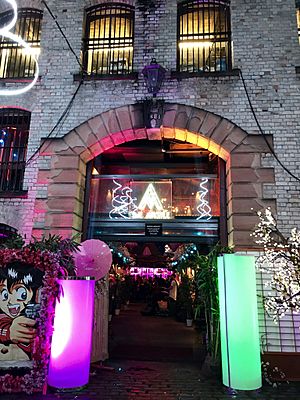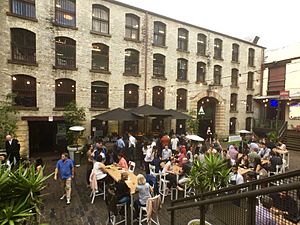Argyle Stores facts for kids
Quick facts for kids Argyle Stores |
|
|---|---|

The entrance to Argyle Stores during Vivid 2017.
|
|
| Location | 12-20 Argyle Street, The Rocks, City of Sydney, New South Wales, Australia |
| Built | 1826–1878 |
| Architect |
|
| Architectural style(s) |
|
| Owner | Property NSW |
| Official name: Argyle Stores; Argyle Bond Stores and Cleland Bond Store | |
| Type | State heritage (built) |
| Designated | 10 May 2002 |
| Reference no. | 1524 |
| Type | Other - Retail & Wholesale |
| Category | Retail and Wholesale |
| Lua error in Module:Location_map at line 420: attempt to index field 'wikibase' (a nil value). | |
The Argyle Stores is a very old building in The Rocks, a historic area in Sydney, Australia. It used to be a place where goods were stored and taxes were paid (a "custom house" and "bond store"). Today, it's a lively spot with offices, a bar, restaurants, and event spaces.
The building was constructed between 1826 and 1878. Some parts were designed by Henry Cooper, but the architects for other parts are unknown. It's also known as Argyle Bond Stores or Cleland Bond Store. The Argyle Stores are owned by Property NSW, a government agency in New South Wales. Because of its long history and special design, it was added to the New South Wales State Heritage Register on 10 May 2002.
Contents
A Look Back: History of Argyle Stores
The land where Argyle Stores stands was first used as gardens for Sydney's first hospital. The very first building on the site started in 1826. Captain John Piper began building what would become the east part of the stores. He sold it to Mary Reiby in 1828. Later that year, Frederick Unwin bought it and finished the building around 1829.
This first building, designed by Henry Cooper, had three levels and was made of stone. In 1831, Samuel Terry bought the site. By 1835, a northern extension was added to the "Customs House." A Customs House was where taxes were collected on goods coming into the country. In 1839, Unwin bought the site again and started building "Unwin's Bonded Stores." These new buildings created a courtyard in the middle. A "bond store" was a place where imported goods could be kept safely until their taxes were paid.
East Wing: The First Part
Construction of the East Wing began in 1826. John Piper oversaw the work. He sold the unfinished building to Mary Reiby in 1828, who then sold it to Frederick Unwin. By 1830, the East Wing was used as the "Custom House." People stored goods like brandy, wine, tea, and tobacco here. Around 1845, the Custom House began moving to Circular Quay.
South Wing: Growing Over Time
The South Wing area was mostly empty until about 1835. A small building was added around this time, possibly for the "Custom House Agent" to live in. By 1876, Isaac Ellis Ives bought the stores. He expanded them, tearing down most of the old South Wing. A new South Wing was built around 1878.
West Wing: Storing Goods
The West Wing of the stores was built between 1840 and 1845. By 1845, it was known as "new stores" with four floors. In 1854, R & E Tooth, famous brewers and merchants, bought these stores. They used the west and north wings to store goods, both taxed and untaxed. The West Wing has not changed much since it was built around 1840.
What the Argyle Stores Look Like
The first building was a simple Georgian style building. It was made of sandstone and had a slate roof. This was one of the first times slate was used for roofs in the colony. Over the years, many brick additions were made. The buildings have strong sandstone cellars. The upper floors use heavy timber beams and posts. The roofs are simple hipped shapes, now covered with corrugated iron.
You enter the courtyard through special passages. These entrances have detailed sandstone arches and quoins (corner stones). The brick walls facing the streets are covered in stucco. Inside, there's even an old hydraulic hoist, which is a special machine for lifting things.
The Argyle Stores show different building styles. These include Colonial Georgian, Victorian Warehouse, and Art Nouveau Chicago. The building has three or four floors plus a basement. It has a stone front, timber floors, and a metal roof. Even with many changes, the buildings still show much of their original design. They tell the story of how they were used as commercial stores over time.
Changes Over the Years
The Argyle Stores have been updated many times:
- 1826-1839 and around 1878: The East Wing was built.
- 1840-45: The West Wing was built.
- 1881: The North Wing was added.
- Around 1878 and 1968-69: The South Wing was built.
- Early 1970s: The stores were changed to become an antique market and other shops.
- 1993: A big renovation happened. The inside was made into open spaces.
- November 1995: The Centre reopened after its major update.
- 1996-97: More air conditioning was added.
- 2006-07: The building and courtyard were updated again. The old hydraulic hoist was fixed.
Why Argyle Stores is Important (Heritage Listing)
The Argyle Stores and its land are very important to the history and science of New South Wales. They also add to the special heritage of The Rocks area. Many groups, like the National Trust, think these stores are very valuable.
The Argyle Stores has some of the oldest surviving commercial buildings in Sydney. Parts of it date back to around 1826. It also has the oldest building used as a Customs House from 1830 to 1850. Even with many changes, the buildings still show how they were used as stores. This includes the old hydraulic hoist. The stores are special because they show how warehouse design changed from the early 1800s to the early 1900s.
The buildings also show how buying and selling goods (wholesale and retail) has changed. They remind us of Sydney's early history. This area was a busy place for ships and trade in the early 1800s. The courtyard is a great example of this history. The buildings are linked to important people in Australian history. These include John Piper, Mary Reiby, Frederick Unwin, Samuel Terry, and the Tooth brothers. The Argyle Centre also makes The Rocks look special.
Studying the building itself can tell us more about its history. This is because there aren't many old documents about it. The history of The Rocks and its buildings shows us how people lived and what they hoped for in the early colony. The way these buildings were built also shows how architecture and building methods changed. The buildings and site can teach us a lot about earlier uses and how the area developed.
The Argyle Stores were one of the first historic buildings in New South Wales to be reused for new purposes. This was done in a way that respected their old history. This makes them an important example of how we protect old buildings. They show us early ideas about saving historical places.
Argyle Stores was added to the New South Wales State Heritage Register on 10 May 2002 for these reasons:
- It shows how history happened: The buildings show how commercial stores developed over time. They also show how retail practices changed. They remind us of Sydney's early history as a busy port. The buildings are connected to important historical figures like Mary Reiby and the Tooth brothers.
- It's linked to important people: The Argyle Centre has ties to early merchants like Mary Reiby and Frederick Unwin. It's also linked to Captain John Piper, the first customs agent. Later, the Tooth brothers, famous Sydney brewers, owned the west wing.
- It looks great: The Argyle Centre makes The Rocks streetscape look very special and historic.
- It's important to the community: People who live in the area and tourists value it as a place for shopping and tourism in The Rocks. It's seen as a successful example of reusing an old warehouse in a good way.
- It can teach us things: The building itself can give us more information about its history. It's one of the oldest commercial buildings in Sydney. It's unique because it shows how warehouse design changed over a long period. The buildings can teach us about early life in the colony and how building methods developed.
- It's rare: The stores are special because they show how warehouse design and construction changed from the early 1800s to the early 1900s.
Images for kids




